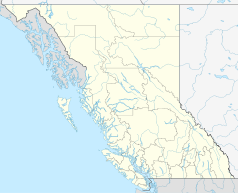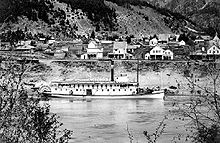Yale (British Columbia)
| Yale | ||
|---|---|---|
 The historic church at Yale |
||
| Location in British Columbia | ||
|
|
||
| State : |
|
|
| Province : | British Columbia | |
| Regional District : | Fraser Valley | |
| Coordinates : | 49 ° 34 ′ N , 121 ° 26 ′ W | |
| Area : | 3.4 km² | |
| Residents : | 143 (as of 2016) | |
| Population density : | 42.1 inhabitants / km² | |
| Time zone : | Pacific Time ( UTC − 8 ) | |
Yale is a settlement in the Canadian province of British Columbia , located on the border between the coastal area known as the Lower Mainland and the arid hinterland known as the plateau . The settlement is located about 23 km north of Hope on Highway 1 , which is part of the Trans-Canada Highway System . Founded in 1848 as the Hudson's Bay Company fort , it was considered the largest city west of Chicago and north of San Francisco during the gold rush era .
The granting of local self-government has not been made for the settlement. The settlement has the status of an unincorporated populated place ( English ), which corresponds approximately to a community-free area .
history
Early history
The region was already visited by humans in the Milliken phase (7500-6000 BC) and Yale is considered to be one of the earliest sites in the history of the coastal Salish . The subsequent Mazama phase (6000–4500 BC) can also be grasped here. The region is the border between the cultural areas of the coastal inhabitants and the plateau dwellers. Above all the Stó: lō moved upstream and caught mainly salmon in the fish-rich fishing grounds .
The residents of the area belong to two groups, the Tait and the Thompson or N'Laka'pamux . The former belong to the Halkomelem language group , the latter spoke N'Laka'pamuxcin. They are more closely related to the groups around Lytton , Boston Bar and Merritt . Nevertheless, the five groups of the Spuzzum and the Tait around Yale are closely related. The families each relate to one ancestor. These are Pelek, Liquitum, Chapmans, Charlies, and Bobbs.
Fur trade
The town's beginnings as a fort date back to 1848 when it was founded and initially run by Ovid Allard on behalf of the Hudson's Bay Company . Allard named the fort after his superior and later Chief Factor of the Columbia District James Murray Yale .
Gold rush
Yale lies on the Fraser River , with the Fraser Canyon beginning immediately to the north. Beyond this point, the river is considered impassable, because there rises a huge boulder, the Lady Franklin Rock. But the city itself was even accessible for steam boats. Its highest population - during the Fraser Canyon War of 1858 - is likely to have been around 15,000, but normally only 5 to 8,000 people lived here, mostly men in search of gold. These prospectors were met at Yale and attempts were made to keep the masses under control. A gunboat on the Fraser River enforced boat and ship license fees from anyone who wanted to go on the river. More than 10,000 men searched for gold between Fort Langley and Fort Yale. The logistics increasingly required American efforts to build roads on the Harrison River route to Lillooet , plus a Muliweg from Yale to Lytton.
The men came here to move further north, into the Cariboo area . Most came up the Fraser River by ship. The Cariboo Road (also called Cariboo Wagon Road or Great North Road ) began in Yale between 1865 and 1885 . The wagon trail led through Barkerville , Lytton, Ashcroft and Quesnel , then on to Williams Creek. Governor James Douglas took out huge loans to finance these road construction in order to remain independent from the United States. In the early 1870s, an overland route to New Westminster was built , which is now called Old Yale Road . Shortly before the development by railroad construction began, the Dewdney Trunk Road to Hatzic , east of Mission City , was also built in these years .
Railway boom
During the construction of the Canadian Pacific Railway , the old town center was destroyed because the railway line ran directly over the main road. The place became the headquarters of the railway contractor Andrew Onderdonk (1848-1905), which gave the city a new boom. The rail link - three trips a day - made Yale a getaway for people from Vancouver from 1885 onwards . But when the railroad was completed that year, the building boom ended and the population declined. Onderdonk, who also left the city in 1886, donated his property to a girls' school that existed until the 1920s.
It was not until 1922 that construction of a new road connection, the Cariboo Highway, began . Again the road was the most important overland connection between the plateau and the coast. After the expansion in the fifties, the Coquihalla Highway was built in the eighties , but this led traffic past Yale.
Demographics
The census in 2016 showed a population of 143 inhabitants for the settlement, after the census in 2011 still showed a population of 136 inhabitants for the municipality. The population has increased by 5.1% compared to the last census in 2011 and is thus close to the provincial average with a population increase in British Columbia of 5.6%.
For the 2016 census, a median age of 60.0 years was determined for the municipality . The median age of the province in 2016 was only 43.0 years. The median age was 56.2 years, or 42.3 years in the province.
Current situation
Most of today's residents belong to the Yale First Nation , which in February 2018, according to the state, numbered exactly 176 people nationwide. All Hallows , the old girls' school, is now a hostel with a campsite, tourism ( rafting , etc.) has increased significantly. The Anglican Church of St. John the Divine is one of the oldest churches in British Columbia. The place maintains the Historic Yale Museum on Douglas Street, as Highway 1 is called within the city. In front of the building from the 1870s, a memorial commemorates the achievements and sufferings of the Chinese workers during the construction of the railway.
Every summer a group of showmen commemorates the role of the Royal Engineers in building the Cariboo Wagon Road and Doulas-Lillooet Trail , as well as their role in McGowan's War (1858).
literature
- Helen B. Akrigg, George Philip Vernon Akrigg: British Columbia Chronicle 1847–1871. Gold and Colonists , Discovery Press, Vancouver 1977.
Web links
Remarks
- ^ Origin Notes and History. Yale. GeoBC , accessed October 4, 2018 .
- ↑ A painting from 1864 shows the fort in the Fraser Gorge: Fort Yale, British Columbia 1864, BC Archives
- ^ Yale (UIP) Community Profile. Census 2016. In: Statistics Canada . April 24, 2018, accessed October 4, 2018 .
- ^ Yale First Nation. Government of Canada - Indigenous and Northern Affairs Canada , March 28, 2017, accessed March 26, 2018 .


